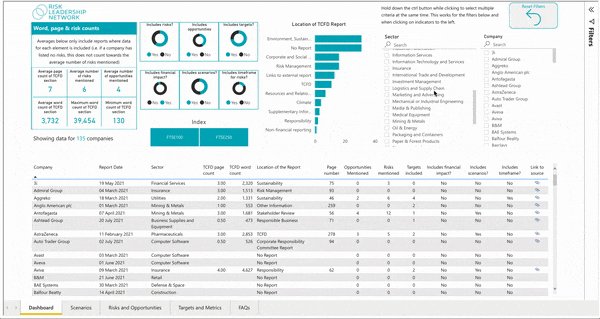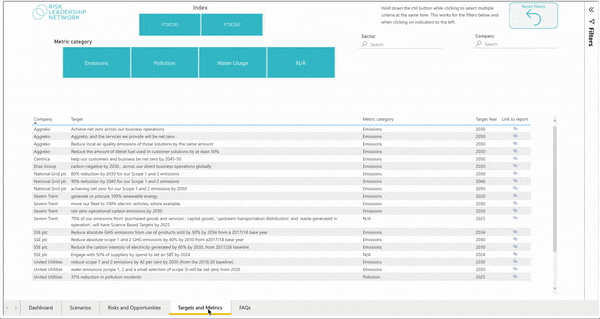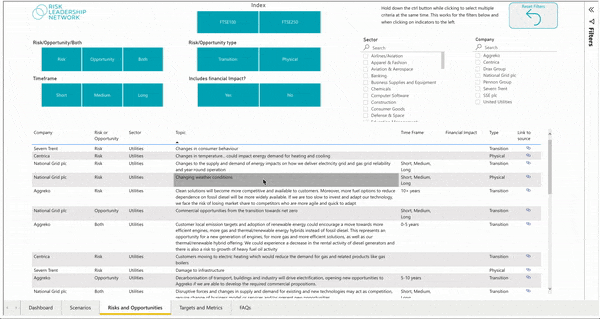TCFD Reporting Comparison Tool NEW
As of 2022, premium listed companies in the UK are required, by law, to disclose how they are managing climate-related threats and opportunities in their annual risk report.
The TCFD Reporting Comparison Tool empowers members to more easily benchmark against listed companies’ approaches to climate risk disclosures, saving them time and strengthening their own methods for this kind of reporting.
Request a demo with our product specialist to discuss how your organisation can leverage the tool to make external TCFD reporting more effective.
Request a demo

See what others are reporting on
Understand how much companies are writing in their TCFD disclosures; in which section of their annual report they are including them; and whether or not these disclosures mention risks, opportunities, targets or scenarios.

Explore targets and metrics
Explore specific targets and metrics, filterable by category, to see what an individual company or sector is aiming to achieve with regards to their climate-related risks (and how they are measuring this).

Identify risks and opportunities
Drill down into the TCFD-related risks and opportunities reported by a specific company, or across a given sector – easily sorting by transitional and physical risks.
See the tool in action
FAQs
TCFD is the Taskforce for Climate-related Financial Disclosures. TCFD requirements are effectively a series of guidelines on how companies should report and manage their climate-related risks and opportunities.
These guidelines comprise four areas that should be reported against: governance, strategy, risk management, and metrics & targets.
As of 2022, premium listed companies in the UK are required, by law, to include a disclosure (based on TCFD guidance) in their annual report. While the UK is the first nation to take this step, it is possible that other countries will enforce similar requirements in the future.
The TCFD Reporting Comparison Tool has a very similar format to our other tools and is delivered via the same platform. The idea is to make it easier for risk managers to find out what other companies are reporting on, with regards to TCFD.
In the case of TCFD, there is a lot of variation between companies in terms of how and where that information is reported in their annual reports, which can make it a challenge for risk managers to locate the information they need in a time-efficient manner.
This year, as part of their annual reporting process, every premium listed company in the UK will need to disclose how they are managing their climate-related risks – in line with TCFD requirements. For the risk team charged with preparing the risk management element of the annual report, trying to locate and gather all of the information they need can be a time-consuming process – however, this can be made easier by seeing what other companies are reporting on.
This tool includes tabs that will help members with the process of identifying risks, opportunities, targets and metrics that listed companies in the UK are mentioning in their annual reports.
The Dashboard tab provides a summary to help members understand how much companies are writing in their TCFD disclosures; in which section of their annual report they are including them; and whether or not these disclosures mention risks, opportunities, targets or scenarios.
Under the Risks and Opportunities tab, risks (and opportunities) can be sorted by whether they are a transition risk (eg a threat or opportunity arising from steps to reduce carbon emissions) or a physical risk (eg what would happen to a business if the temperature was to rise globally).
There is also a timeframe option, so members can stratify short-, medium- or long-term risks which may impact their organisation.
As with our other tools, members can also drill down further and look at the TCFD-related risks reported by a specific company, or across a given sector.
The same can be said for the Targets and Metrics tab (members can drill down further into specific targets and metrics), which also allows members to see what an individual company or specific sector is
- aiming to achieve with regards to their climate-related risks, and
- how they are measuring this
These targets and metrics can be filtered by category, which include: emissions, pollution, resource usage, waste and water usage.
Finally, under the Scenarios tab, members can see how companies are reporting against a host of different situations which may materialise, depending on how climate change evolves.
These scenarios can be filtered by source – for example, some derive from the IPCC, while others are developed in-house by individual companies – and, as with the other tabs, by individual company and sector.
In the future, we plan to align the tool closer to the TCFD guideline structure, which would mean adding tabs for both governance and strategy.
However, more so than our other tools on risk reporting and emerging risk, this may take time to develop, as TCFD is a brand new reporting requirement and there isn’t much consistency yet in how companies cover this in their annual report.
As the consistency of disclosures increases, it will become easier to draw out additional data points that we can then feed into the tool.